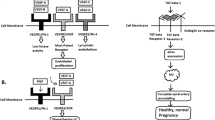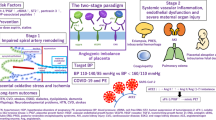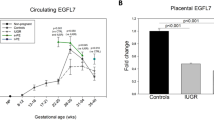Abstract
Hypertensive disorders are the most common medical problem encountered during pregnancy due to defective angiogenesis during placental development. Vascular endothelial growth factor (VEGF) is one of the angiogenic growth factors that stimulates angiogenesis. The recombinant form of its soluble receptor VEGF receptor-2 (sVEGFR-2) has anti-angiogenic activity. However, there is a paucity of information on serum VEGF and sVEGFR-2 concentrations in different sub-groups of hypertensive disorders during pregnancy. In this cross-sectional study, we evaluated the concentrations and the diagnostic utility of VEGF and sVEGFR-2 in gestational hypertension (GH, n=90), pre-eclampsia (PE, n=180), eclampsia (n=90) and control (n=180) pregnancy at different gestations. VEGF levels were significantly higher in PE and eclamptic (median=19.53 pg ml−1; 60.36 pg ml−1, P=0.0001) groups as compared with the control ones (median=18 pg ml−1). But, the serum sVEGFR-2 levels were found to be significantly decreased from GH to eclampsia groups (median=5196; 3972 pg ml−1) as compared with control groups (median=7417 pg ml−1). As the gestation advanced, there was an inverse association in the serum concentrations of sVEGFR-2 among the control, GH, PE and eclampsia groups. At both ⩽34 and >34 weeks of gestations, higher sensitivity and specificity were observed for sVEGFR-2 in differentiating GH (50.8, 50%; 76.6, 76.6%), PE (63, 63%; 90, 90%) and eclampsia (65, 66.6%; 90, 90%) from the control pregnancy. This upregulation of VEGF and downregulation of sVEGFR-2 concentrations in different study groups may be due to hypoxia and could be involved intimately in the pathogenesis of these disorders. This study may contribute in understanding etio-pathogenesis of different hypertensive disorders during pregnancy.
This is a preview of subscription content, access via your institution
Access options
Subscribe to this journal
Receive 12 digital issues and online access to articles
$119.00 per year
only $9.92 per issue
Buy this article
- Purchase on Springer Link
- Instant access to full article PDF
Prices may be subject to local taxes which are calculated during checkout


Similar content being viewed by others
References
Roberts JM, Cooper DW . Pathogenesis and genetics of pre-eclampsia. Lancet 2001; 357: 53.
National high blood pressure education program working group on high blood pressure in pregnancy. Report of the National high blood pressure education program working group on high blood pressure in pregnancy. Am J Obst Gyne 2000; 183: s1–s22.
Roberts JM, Lain KY . Recent insight into the pathogenesis of pre-eclampsia. Placenta 2002; 23: 359–372.
Granger JP, Alexander BT, Llinas MT, Bennett WA, Khalil RA . Pathophysiology of preeclampsia: linking placental ischemia/hypoxia with microvascular dysfunction. Microcirculation 2002; 9 (3): 147–160.
Redman CW, Sargent IL . Latest advances in understanding pre-eclampsia. Science 2005; 8: 592–1594.
Ebos JM, Bocci G, Man S, Thorpe PE, Hicklin DJ, Zhou D et al. A naturally occurring soluble form of vascular endothelial growth factor receptor-2 detected in mouse and human plasma. Mol Cancer Res 2004; 2: 315–326.
Ferrara N, Gerber HP, LeCouter J . The biology of VEGF and its receptors. Nat Med 2003; 9: 669–676.
Agostini H, Boden K, Unsold A, Martin G, Hansen L, Fiedler U et al. A single local injection of recombinant VEGF receptor 2 but not of Tie2 inhibits retinal neovascularization in the mouse. Curr Eye Res 2005; 30: 249–257.
Shalaby F, Rossant J, Yamaguchi TP, Gertsenstein M, Wu XF, Breitman ML . Failure of blood-island formation and vasculogenesis in Flk-1-deficient mice. Nature 1995; 376: 62–66.
Carmeliet P, Ferreira V, Breier G, Pollefeyt S, Kieckens L, Gertsenstein M et al. Abnormal blood vessel development and lethality in embryos lacking a single VEGF allele. Nature 1996; 380: 435–439.
Aiello LP, Pierce EA, Foley ED, Takagi H, Chen H, Riddle L et al. L, Smith LE suppression of retinal neovascularization in vivo by inhibition of VEGF using soluble VEGF-receptor chimeric proteins. Proc Natl Acad Sci USA 1995; 92: 457–461.
Rodesch F, Simon P, Donner C, Jauniaux E . Oxygen measurements in endometrial and trophoblastic tissues during early pregnancy. Obstet Gynecol 1992; 80: 283–285.
Ferrara N, Gerber H . The role of vascular endothelial growth factor in angiogenesis. Acta Haematol 2001; 106: 148–156.
Neufeld G, Cohen T, Gengrinovitch S, Poltorak Z . Vascular endothelial growth factor (VEGF) and its receptors. FASEB J 1999; 13: 9–22.
Eremina V, Sood M, Haigh J, Nagy A, Lajoie G, Ferrara N et al. Glomerular-specific alterations of VEGF-A expression lead to distinct congenital and acquired renal diseases. J Clin Invest 2003; 111: 707–716.
Baker PN, Krasnow J, Roberts JM, Yeo KT . Elevated serum levels of vascular endothelial growth factor in patients with pre-eclampsia. Obstet Gynecol 1995; 86: 815–821.
Sharkey AM, Cooper JC, Balmforth JR, Mclaren J, Clark DE, Charnock-Jones DS et al. Maternal plasma levels of vascular endothelial growth factor in normotensive pregnancies and pregnancies complicated by pre-eclampsia. Eur J Clin Invest 1996; 26: 1182–1185.
Lyall F, Greer IA, Boswell F, Fleming R . Suppression of serum vascular endothelial growth factor immunoreactivity in normal pregnancy and in pre-eclampsia. Br J Obstet Gynecol 1997; 104: 223–228.
Chaiworapongsa T, Romero R, Gotsch F, Espinoza J, Nien JK, Goncalves L et al. Low maternal concentrations of soluble vascular endothelial growth factor receptor-2 in preeclampsia and small for gestation age. J Matern Fetal Neonatal Med 2008; 21: 41–52.
Tripathi R, Rath G, Jain A, Salhan S . Soluble and membranous vascular endothelial growth factor receptor-1 in pregnancies complicated by pre-eclampsia. Ann Anat 2008; 190: 477–489.
Chaiworapongsa T, Romero R, Espinoza J, Bujold E, Mee KY, Goncalves LF et al. Evidence supporting a role for blockade of the vascular endothelial growth factor system in the pathophysiology of pre-eclampsia. Young Investigator Award. Am J Obstet Gynecol 2004; 190: 1541–1547.
Oh MJ, Shin JC, Popek EJ . Vascular endothelial growth factor expression in patients complicated pre-eclampsia. Korean J Obstet Gynecol 2001; 44: 1877–1882.
Lee ES, Oh MJ, Jung JW, Lim JE, Seol HJ, Lee KJ et al. The Levels of circulating vascular endothelial growth factor and soluble Flt-1 in pregnancies complicated by pre-eclampsia. J Korean Med Sci 2007; 22 (1): 94–98.
Levine RJ, Maynard SE, Qian C, Lim KH, Lucinda J, Yu KF et al. Circulating angiogenic factors and the risk of pre-eclampsia. N Engl J Med 2004; 350: 672–683.
Hunter A, Aitkenhead M, Caldwell C, McCracken G, Wilson D, McClure N . Serum levels of vascular endothelial growth factor in preeclamptic and normotensive pregnancy. Hypertension 2000; 36 (6): 965–969.
Tammela T, Enholm B, Alitalo K, Paavonen K . The biology of vascular endothelial growth factors. Cardiovasc Res 2005; 65: 550–563.
Faderl S, Do KA, Johnson MM, Keating M, O’brien S, Jilani I et al. Angiogenic factors may have a different prognostic role in adult acute lymphoblastic leukemia (ALL). Blood 2005; 106: 4303–4307.
Masuyama H, Suwaki N, Nakatsukasa H, Masumoto A, Tateishi Y, Hiramatrsu Y . Circulating angiogenic factors in pre-eclampsia, gestational proteinuria and pre-eclampsia superimposed on chronic glomerulonephritis. Am J Obstet Gynecol 2006; 194: 551–556.
Wallner W, Sengenberger R, Strick R, Strissel PL, Meurer B, Beckmann MW et al. Angiogenic growth factors in maternal and fetal serum in pregnancies complicated by intrauterine growth restriction. Clin Sci (Lond) 2007; 112 (1): 51–57.
Kendall RL, Thomas KA . Inhibition of VEGF activity by an endogenously encoded soluble receptor. Proc Natl Acad Sci USA 1993; 90: 10705–10709.
Ebos JM, Lee CR, Bogdanovic E, Alami J, Slyke PV, Francia G et al. Vascular endothelial growth factor–mediated decrease in plasma soluble vascular endothelial growth factor receptor-2 levels as a surrogate biomarker for tumor growth. Cancer Res 2008; 68 (2): 521–529.
Rahimi N . VEGFR-1 and VEGFR-2: two non-identical twins with a unique physiognomy. Front Biosci 2006; 11: 818–829.
Gerber HP, Condorelli F, Park J, Ferrara N . Differential transcriptional regulation of the two vascular endothelial growth factor receptor genes. Flt-1, but not Flk-1/KDR, is upregulated by hypoxia. J Biol Chem 1997; 272: 23659–23667.
Kim SY, Park SY, Kim JW, Kim YM, Yang JH, Kim MY . Circulating endothelial progenitor cells, plasma VEGF, and VEGFR-1 and VEGFR-2 levels in pre-eclampsia. Am J Obstet Gynecol 2005; 193: S74.
Werner N, Kosiol S, Schiegl T, Ahlers P, Walenta K, Link A . Circulating endothelial progenitor cells and cardiovascular outcomes. N Engl J Med 2005; 353: 999–1007.
Ray JG, Vermeulen MJ, Schull MJ, Redelmeier DA . Cardiovascular health after maternal placental syndromes (CHAMPS): population-based retrospective cohort study. Lancet 2005; 366: 1797–1803.
Roberts DM, Kearney JB, Johnson JH, Rosenberg MP, Kumar R, Bautch VL . The vascular endothelial growth factor (VEGF) receptor Flt-1 (VEGFR-1) modulates Flk- 1 (VEGFR-2) signaling during blood vessel formation. Am J Pathol 2004; 164: 1531–1535.
Maynard SE, Min JY, Merchan J, Lim KH, Li J, Mondal S et al. Excess placental soluble fms-like tyrosine kinase 1(sFlt-1) may contribute to endothelial dysfunction, hypertension and proteinuria in pre-eclampsia. J Clin Invest 2003; 111: 649–658.
Seetharam L, Gotoh N, Maru Y, Neufeld G, Yamaguchi S, Shibuya M . A unique signal transduction from Flt tyrosine kinase, a receptor for vascular endothelial growth factor (VEGF). Oncogene 1995; 10: 135–147.
Soker S, Takashima S, Miao HQ, Neufeld G, Klagsbrun M . Neuropilin-1 is expressed by endothelial and tumor cells as an isoform-specific receptor for vascular endothelial growth factor. Cell 1998; 92: 735–745.
Burton GJ, Woods AW, Jauniaux E, Kingdom JC . Rheological and physiological consequences of conversion of the maternal spiral arteries for uteroplacental blood flow during human pregnancy. Placenta 2009; 30 (6): 473–482.
Escudero C, Puebla C, Westermeier F, Sobrevia L . Potential cell signalling mechanisms involved in differential placental angiogenesis in mild and severe pre-eclampsia. Curr Vasc Pharmacol 2009; 7 (4): 475–485.
Roy H, Bhardwaj S, Ylä-Herttuala S . Biology of vascular endothelial growth factors. FEBS Letters 2006; 580 (12): 2879–2887.
Munaut C, Lorquet S, Pequeux C, Blacher S, Berndt S, Frankenne F et al. Hypoxia is responsible for soluble vascular endothelial growth factor receptor-1 (VEGFR-1) but not for soluble endoglin induction in villous trophoblast. Hum Reprod 2008; 23 (6): 1407–1415.
Wilting J, Birkenhager R, Eichmann A, Kurz H, Martinybaron G, Marme D et al. VEGF(121) induces proliferation of vascular endothelial cells and expression of flk-1 without affecting lymphatic vessels of the chorioallantoic membrane. Dev Biol 1996; 176: 76–85.
Kumazaki K, Nakayama M, Suehara N, Wada Y . Expression of vascular endothelial growth factor, placental growth factor, and their receptors Flt-1 and KDR in human placenta under pathological conditions. Hum Pathol 2002; 33: 1069–1077.
Salahuddin S, Young L, Vadnais M, Benjamin P, Sachs S, Karumanchi A et al. Diagnostic utility of soluble fms-like tyrosine kinase 1 and soluble endoglin in hypertensive diseases of pregnancy. Amer J Obst Gynec 2007; 197: 28.e1–28.e6.
Acknowledgements
This work was supported by a grant of Council of Scientific and Industrial Research (CSIR Project No. 27-0133/04/EMR II), New Delhi, India. Grants: Council of scientific and Industrial Research.
Author information
Authors and Affiliations
Corresponding author
Ethics declarations
Competing interests
The authors declare no conflict of interest.
Additional information
Supplementary Information accompanies the paper on the Journal of Human Hypertension website
Supplementary information
Rights and permissions
About this article
Cite this article
Rath, G., Tripathi, R. VEGF and its soluble receptor VEGFR-2 in hypertensive disorders during pregnancy: the Indian scenario. J Hum Hypertens 26, 196–204 (2012). https://doi.org/10.1038/jhh.2011.17
Received:
Revised:
Accepted:
Published:
Issue Date:
DOI: https://doi.org/10.1038/jhh.2011.17
Keywords
This article is cited by
-
Concentrations of endothelial nitric oxide synthase, angiotensin-converting enzyme, vascular endothelial growth factor and placental growth factor in maternal blood and maternal metabolic status in pregnancy complicated by hypertensive disorders
Journal of Human Hypertension (2014)
-
Soluble VEGFR-1 in pathophysiology of pregnancies complicated by hypertensive disorders: the Indian scenario
Journal of Human Hypertension (2013)
-
Angiogenic balance and diagnosis of pre-eclampsia: selecting the right VEGF receptor
Journal of Human Hypertension (2012)
-
Angiogenic balance and diagnosis of pre-eclampsia: selecting the right VEGF receptor
Journal of Human Hypertension (2012)



